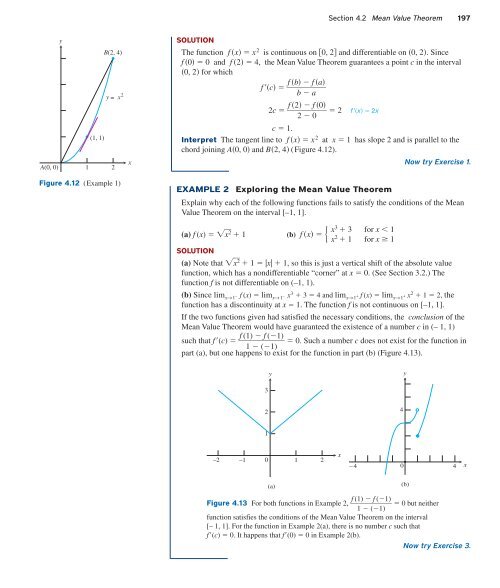5128_Ch04_pp186-260
You also want an ePaper? Increase the reach of your titles
YUMPU automatically turns print PDFs into web optimized ePapers that Google loves.
Section 4.2 Mean Value Theorem 197<br />
y<br />
B(2, 4)<br />
y = x 2<br />
(1, 1)<br />
A(0, 0) 1 2<br />
Figure 4.12 (Example 1)<br />
x<br />
SOLUTION<br />
The function f x x 2 is continuous on 0, 2 and differentiable on 0, 2. Since<br />
f 0 0 and f 2 4, the Mean Value Theorem guarantees a point c in the interval<br />
0, 2 for which<br />
f c f b f a<br />
<br />
b a<br />
2c f 2 f 0<br />
2<br />
2 0<br />
c 1.<br />
fx 2x<br />
Interpret The tangent line to f x x 2 at x 1 has slope 2 and is parallel to the<br />
chord joining A0, 0 and B2, 4 (Figure 4.12).<br />
EXAMPLE 2<br />
Exploring the Mean Value Theorem<br />
Now try Exercise 1.<br />
Explain why each of the following functions fails to satisfy the conditions of the Mean<br />
Value Theorem on the interval [–1, 1].<br />
(a) f (x) x 2 1<br />
(b)<br />
x 3 3 for x 1<br />
f x { x<br />
2<br />
1 for x 1<br />
SOLUTION<br />
(a) Note that x 2 1 |x| 1, so this is just a vertical shift of the absolute value<br />
function, which has a nondifferentiable “corner” at x 0. (See Section 3.2.) The<br />
function f is not differentiable on (–1, 1).<br />
(b) Since lim x→1<br />
– f (x) lim x→1<br />
– x 3 3 4 and lim x→1<br />
+ f (x) lim x→1<br />
+ x 2 1 2, the<br />
function has a discontinuity at x 1. The function f is not continuous on [–1, 1].<br />
If the two functions given had satisfied the necessary conditions, the conclusion of the<br />
Mean Value Theorem would have guaranteed the existence of a number c in (– 1, 1)<br />
such that f(c) f (1 ) f (1)<br />
0. Such a number c does not exist for the function in<br />
1 ( 1)<br />
part (a), but one happens to exist for the function in part (b) (Figure 4.13).<br />
y<br />
y<br />
3<br />
2<br />
4<br />
1<br />
–2 –1 0<br />
1 2<br />
x<br />
– 4<br />
0<br />
4<br />
x<br />
(a)<br />
Figure 4.13 For both functions in Example 2, f (1 ) f (1)<br />
0 but neither<br />
1 ( 1)<br />
function satisfies the conditions of the Mean Value Theorem on the interval<br />
[– 1, 1]. For the function in Example 2(a), there is no number c such that<br />
f(c) 0. It happens that f(0) 0 in Example 2(b).<br />
(b)<br />
Now try Exercise 3.












